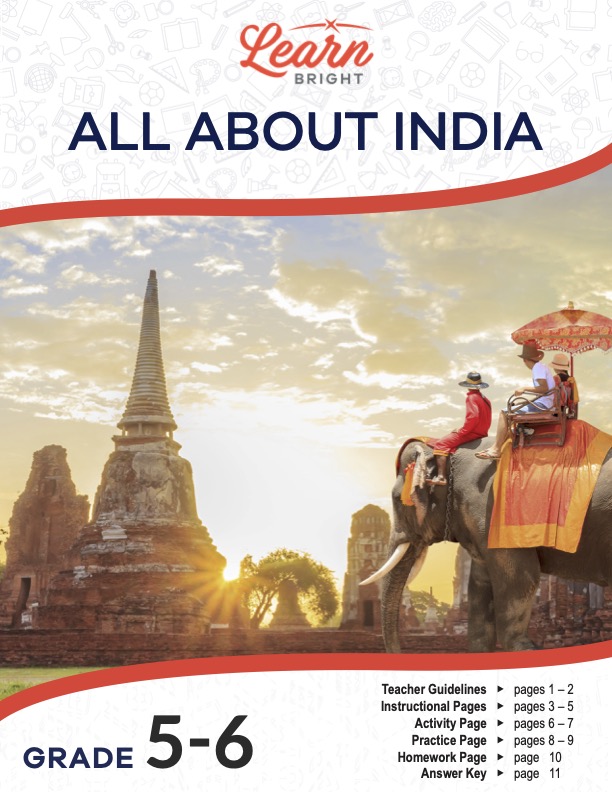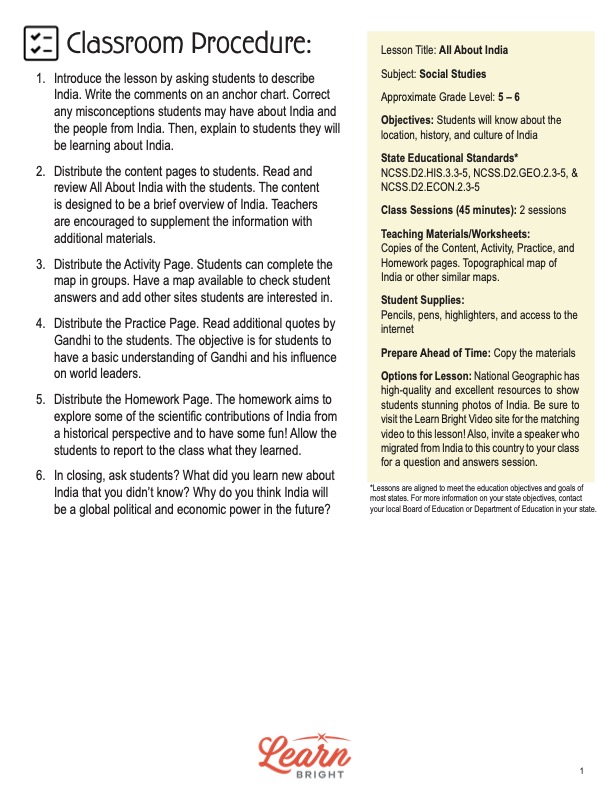Description
What our All about India lesson plan includes
Lesson Objectives and Overview: All about India explores the amazing history and culture of the people of India. Students will learn about this incredible country and some of the significant events and people of its history, such as Mahatma Ghandi. They will also discover where India is located on a map. This lesson is for students in 5th grade and 6th grade.
Classroom Procedure
Every lesson plan provides you with a classroom procedure page that outlines a step-by-step guide to follow. You do not have to follow the guide exactly. The guide helps you organize the lesson and details when to hand out worksheets. It also lists information in the yellow box that you might find useful. You will find the lesson objectives, state standards, and number of class sessions the lesson should take to complete in this area. In addition, it describes the supplies you will need as well as what and how you need to prepare beforehand. For this lesson, you will need pencils, pens, highlighters, and a topographical map of India (or similar maps).
Options for Lesson
The “Options for Lesson” section of the classroom procedure page lists a number of suggestions for ideas and activities you could incorporate into the lesson. One idea is to take advantage of the excellent resources from National Geographic and show your students stunning photos of India. You could also show the Learn Bright video about India to your students to supplement the lesson plan. Another option is to invite a speaker who migrated from India to speak to the class and answer their questions.
Teacher Notes
The paragraph on this page provides a little more information or guidance on what to expect from the lesson. It explains that this lesson does not aim to be all encompassing of India. Instead, the objective is to provide a basic overview of one of the fastest-growing economic and political powers. You can use the blank lines to record any thoughts or ideas you have as you prepare.
ALL ABOUT INDIA LESSON PLAN CONTENT PAGES
Flag and Geography
The All about India lesson plan has three pages of content. It begins by explaining the significance of the country’s flag. The flag of India boasts one of the most unique designs in the world. The first strip is saffron colored. Saffron is an expensive spice from India and Asia. The saffron stripe represents courage and strength. The white band with the blue spoked symbol represents peace and truth in harmony with the Dharma Chakra, a religious symbol meaning the wheel of the law. The green stripe represents the land, agriculture, and the deep ties to the productivity of the land. The flag of India describes the values of India’s people, culture, religious traditions, and contributions to civilization.
India is located on the continent of Asia, specifically South Asia. One of the unique features of India is that it is a peninsula (land surrounded by water on three sides). In the north is the famous and world’s highest mountain range, the Himalayas. There is a diverse ecosystem making up the terrain of India. In the northeast are jungles, and the Thar Desert covers part of western India.
One of the most important areas for farming is in the north, known as the Indus-Ganga Plains. The plains were formed over hundreds of thousands of years from soil deposits left by flowing rivers from the Himalayan mountains. The Ganges River is approximately 2,500 kilometers (about 1,555 miles long) and is critical to wildlife and agriculture. Hundreds of millions of people make their homes along the river and in the fertile plains created by the river’s flow.
There are about 65,000 different animal species in India. India is home to elephants, pythons, dolphins, river dolphins, and rhinos. The snow leopard makes its home in the Himalayas along with bears. India has both tigers and lions living in the jungles. Tigers swim in the same rivers as saltwater crocodiles and sharks. Several species of birds populate India as well. It is estimated more than 12,000 plant species can be found in this beautiful country.
History of India
India’s history began more than 5,000 years ago. As a result, India is one of the oldest cultures in the world. Around 1500 BCE, a group of farmers called the Aryans migrated from central Asia to settle near the rivers and plains of India. Although they were primarily farmers, their culture was advanced. They spoke the Sanskrit language and created the Vedic Scriptures, a sophisticated religion that formed the early basis of Hinduism.
In the fourth century CE, Aryabhatta, an Indian astronomer, determined the Earth revolved around the sun. This was a remarkable scientific discovery, considering Copernicus did not publish this idea until 1543. And Galileo did not have use of a telescope until the 1600s. During the reign of the Gupta Empire, several discoveries were made in math, science, and the arts.
Fast forward to the 16th century, several groups invaded India. The Mongols, led by Babur, founded the Mongol Empire and expelled Muslim invaders. For the next 200 years, the Mongols built roads, mosques, tombs, and enormous gardens, providing stability to the country. The Taj Mahal is one of the most famous buildings the people constructed during this time.
Gandhi, Government, and Economy
By the 1400s, European explorers seeking trade relations with
Asian countries began setting up trading companies in India. Then, in 1457, the British Empire took control of India. This is what we call colonialism, when one government tries to colonize or take over another to gain control over its natural resources. In 1856, the people of India had grown frustrated with British rule, and an uprising occurred.
The people of India wanted to self-govern and, through protests, pushed the British out of India. Mahatma Gandhi led the protests. He is famous for promoting non-violent protests as a way to change the conditions in a country. Gandhi’s idea of non-violent protests influenced Martin Luther King, Jr., in the United States to organize his campaign for civil rights! Finally, in 1947, India were free from British rule and became a separate nation.
After the British left, India adopted a similar style of government as the British. India is a parliamentary democracy. Several parties competed for seats in the government. The leader of the government is the prime minister. The parliament chooses the prime minister to represent and lead the government.
In recent years, India has had exponential economic growth. It is the world’s fifth largest economy, and most economists believe it will continue to grow. As a result, India has become a key player in the global market. Textiles and agriculture remain India’s most productive sectors in the marketplace. However, the country is fast becoming a technology center for many of the world’s largest companies.
Indian Culture
India can be described as a very spiritual or religious culture. About 80% of the people in India practice Hinduism, while 13% are Muslim. Other religions, including Buddhism, Sikhism, and Jainism, are also prevalent. More than 1.6 billion people live in India. It is the second most populated country in the world and continues to grow. India’s population growth is due to better health conditions, a lower death rate, and improved economic growth.
In general, most Indians are proud of their history and cultural contributions to the world. They place a high value on harmony, unity with others, and family. This may explain how a country with crowded cities teeming with millions of people and diverse cultures can function as a society. One unique element in India’s society is the caste system.
When a society is divided up by social ranks, that is called a caste system. For example, in India are two major castes. The first includes those who have accumulated wealth or are highly educated, priests, landowners, and business people. The second group consists of those who do manual labor, are under-educated, or work in jobs that require little technical skill. Sometimes called the untouchables, the people in this caste are generally very poor. The caste system in India is determined by birth. According to recent surveys, nearly all Indians identify with a caste.
India today is fast becoming one of the most important global nations. Modern cities and high technology are driving the new India. With continuous economic improvement comes a desirable market in which companies want to locate and sell goods. India is a leader in Asia and is recognized by many democratic countries as a reliable partner in global affairs.
ALL ABOUT INDIA LESSON PLAN WORKSHEETS
The All about India lesson plan includes three worksheets: an activity worksheet, a practice worksheet, and a homework assignment. Each one will reinforce students’ comprehension of lesson material in different ways and help them demonstrate when they learned. Use the guidelines on the classroom procedure page to determine when to distribute each worksheet to the class.
LABEL THE MAP ACTIVITY WORKSHEET
Students will review a list of places and mark them on the map. In total, they will find 18 specific in India or surrounding areas, such as Pakistan, Thar Desert, coastal plains, and the Bay of Bengal. On the second worksheet page is a box of additional facts students can learn about India.
INFLUENCE OF GANDHI PRACTICE WORKSHEET
The practice worksheet requires students to read a passage about Mahatma Gandhi. Then they will read three statements. For each statement, they will explain what they believe the meaning is.
ALL ABOUT INDIA TECHNOLOGY HOMEWORK ASSIGNMENT
For the homework assignment, students will choose from a list of eight technological advances from India. They will write a paragraph that explains its significance and importance in history. Options include Pythagorean theorem, cataract surgery, and weighing scale.
Worksheet Answer Keys
The lesson document provides answer keys for the practice and homework worksheets. The correct answers are in red to make it easy to compare them to students’ work. Given the nature of the homework assignment, student answers will vary. Thus, the answer key for this worksheet provides a sample response only. If you choose to administer the lesson pages to your students via PDF, you will need to save a new file that omits these pages. Otherwise, you can simply print out the applicable pages and keep these as reference for yourself when grading assignments.










